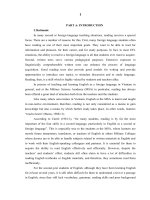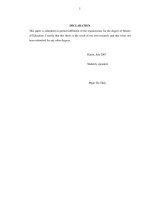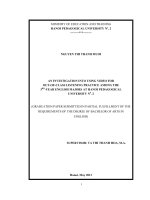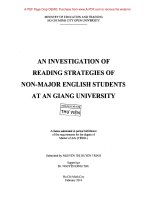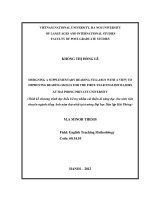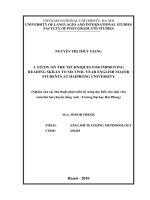Effective methods for further reading improvement of first year english majors at HPU
Bạn đang xem bản rút gọn của tài liệu. Xem và tải ngay bản đầy đủ của tài liệu tại đây (2.14 MB, 75 trang )
BỘ GIÁO DỤC VÀ ĐÀO TẠO
TRƯỜNG ĐẠI HỌC DÂN LẬP HẢI PHÒNG
------------------------------ISO 9001:2015
KHÓA LUẬN TỐT NGHIỆP
NGÀNH: NGOẠI NGỮ
Sinh viên
: BÙI THỊ HÀ
Giảng viên hướng dẫn: Th.s NGUYỄN THỊ HUYỀN
HẢI PHÒNG - 2019
BỘ GIÁO DỤC VÀ ĐÀO TẠO
TRƯỜNG ĐẠI HỌC DÂN LẬP HẢI PHÒNG
-----------------------------------
EFFECTIVE METHODS FOR FURTHER READING
IMPROVEMENT OF FIRST YEAR ENGLISH MAJORS AT
HAI PHONG PRIVATE UNIVERSITY
KHÓA LUẬN TỐT NGHIỆP ĐẠI HỌC HỆ CHÍNH QUY
NGÀNH: NGOẠI NGỮ
Sinh viên
: BÙI THỊ HÀ
Giảng viên hướng dẫn: Th.s NGUYỄN THỊ HUYỀN
HẢI PHÒNG - 2019
BỘ GIÁO DỤC VÀ ĐÀO TẠO
TRƯỜNG ĐẠI HỌC DÂN LẬP HẢI PHÒNG
--------------------------------------
NHIỆM VỤ ĐỀ TÀI TỐT NGHIỆP
Sinh viên: Bùi Thị Hà
Mã SV: 1412401252
Lớp: NA1901A
Ngành: Ngoại Ngữ
Tên đề tài: Effective methods for further reading improvement of first
year English majors at HPU
NHIỆM VỤ ĐỀ TÀI
1. Nội dung và các yêu cầu cần giải quyết trong nhiệm vụ đề tài tốt nghiệp
( về lý luận, thực tiễn, các số liệu cần tính toán và các bản vẽ).
……………………………………………………………………………..
……………………………………………………………………………..
……………………………………………………………………………..
……………………………………………………………………………..
……………………………………………………………………………..
2. Các số liệu cần thiết để thiết kế, tính toán.
……………………………………………………………………………..
……………………………………………………………………………..
……………………………………………………………………………..
……………………………………………………………………………..
……………………………………………………………………………..
3. Địa điểm thực tập tốt nghiệp.
……………………………………………………………………………..
……………………………………………………………………………..
……………………………………………………………………………..
CÁN BỘ HƯỚNG DẪN ĐỀ TÀI TỐT NGHIỆP
Người hướng dẫn thứ nhất:
Họ và tên:.............................................................................................
Học hàm, học vị:...................................................................................
Cơ quan công tác:.................................................................................
Nội dung hướng dẫn:............................................................................
Người hướng dẫn thứ hai:
Họ và tên:.............................................................................................
Học hàm, học vị:...................................................................................
Cơ quan công tác:.................................................................................
Nội dung hướng dẫn:............................................................................
Đề tài tốt nghiệp được giao ngày … tháng ….. năm …..
Yêu cầu phải hoàn thành xong trước ngày …. tháng ….. năm ……
Đã nhận nhiệm vụ ĐTTN
Đã giao nhiệm vụ ĐTTN
Sinh viên
Người hướng dẫn
Hải Phòng, ngày ...... tháng........năm 20..
Hiệu trưởng
GS.TS.NGƯT Trần Hữu Nghị
CỘNG HÒA XÃ HỘI CHỦ NGHĨA VIỆT NAM
Độc lập - Tự do - Hạnh phúc
PHIẾU NHẬN XÉT CỦA GIẢNG VIÊN HƯỚNG DẪN TỐT NGHIỆP
Họ và tên giảng viên:
...................................................................................................
Đơn vị công tác:
........................................................................ ..........................
Họ và tên sinh viên:
.......................................... Chuyên ngành: ...............................
Nội dung hướng dẫn:
.......................................................... ........................................
............................................................................................................................
Tinh thần thái độ của sinh viên trong quá trình làm đề tài tốt nghiệp
.............................................................................................................................................
.............................................................................................................................................
.............................................................................................................................................
1. Đánh giá chất lượng của đồ án/khóa luận (so với nội dung yêu cầu đã đề
ra trong nhiệm vụ Đ.T. T.N trên các mặt lý luận, thực tiễn, tính toán số
liệu…)
.............................................................................................................................................
................................................................................................................................
.............................................................................................................................................
3. Ý kiến của giảng viên hướng dẫn tốt nghiệp
Được bảo vệ
Không được bảo vệ
Điểm hướng dẫn
Hải Phòng, ngày … tháng … năm ......
Giảng viên hướng dẫn
(Ký và ghi rõ họ tên)
QC20-B18
CỘNG HÒA XÃ HỘI CHỦ NGHĨA VIỆT NAM
Độc lập - Tự do - Hạnh phúc
PHIẾU NHẬN XÉT CỦA GIẢNG VIÊN CHẤM PHẢN BIỆN
Họ và tên giảng viên:
..............................................................................................
Đơn vị công tác:
........................................................................ .....................
Họ và tên sinh viên:
...................................... Chuyên ngành: ..............................
Đề tài tốt nghiệp:
......................................................................... ....................
............................................................................................................................
1. Phần nhận xét của giáo viên chấm phản biện
..........................................................................................................................................
............................................................................................................................
.............................................................................................................................................
..........................................................................................................................................
..........................................................................................................................................
2. Những mặt còn hạn chế
.............................................................................................................................................
..........................................................................................................................................
..........................................................................................................................................
..........................................................................................................................................
..........................................................................................................................................
..........................................................................................................................................
3. Ý kiến của giảng viênchấm phản biện
Được bảo vệ
Không được bảo vệ
Điểm hướng dẫn
Hải Phòng, ngày … tháng … năm ......
Giảng viênchấm phản biện
(Ký và ghi rõ họ tên)
QC20-B19
Table of contents
DECLARATION............................................................................................... 10
ACKNOWLEDGEMENTS.............................................................................. 11
List of tables and charts .................................................................................... 12
PART 1: INTRODUCTION............................................................................... 1
1.1 Rationale for the study .................................................................................. 1
1.2 Aims of the study ........................................................................................... 2
1.3 Research questions ........................................................................................ 2
1.4 Methods of the study ..................................................................................... 2
1.4.1 Participants ................................................................................................... 2
1.4.2 Instruments ................................................................................................... 2
1.5 Scope of the study .......................................................................................... 3
1.6 Significance of the study ............................................................................... 3
1.7 Design of study ............................................................................................... 3
PART 2: DEVELOPMENT ............................................................................... 5
CHAPTER 1: LITERATURE REVIEW.......................................................... 5
1.1 Theoretical background ................................................................................ 5
1.1.1 Definition of reading .................................................................................. 5
1.1.2 Definition of reading comprehension ....................................................... 6
1.1.3 Process of reading comprehension skill ................................................... 7
1.1.4 Types of reading skill ................................................................................. 8
1.1.4.1 According to purpose .............................................................................. 8
1.1.4.2 According to manner ............................................................................ 11
1.2. Importance of learning English reading skill .......................................... 12
1.3 Difficulties in learning the reading skill .................................................... 14
1.4 Factors affecting reading difficulties ......................................................... 16
CHAPTER 2: THE STUDY............................................................................. 22
2.1 Participants .................................................................................................. 22
2.2 Data collection instrument ......................................................................... 23
2.3 Procedures of data collection..................................................................... 23
2.4 Data analysis and Findings.........................................................................23
CHAPTER 3: SOME SUGGESTIONS TO IMPROVE STUDENTS’
READING SKIll.............................................................................................................................. 36
3.1 Suggestions for teachers.............................................................................................................. 36
PART 3: CONCLUSION..................................................................................57
1. Conclusion of research..................................................................................57
2. Limitations of study......................................................................................57
3. Recommendations for further study........................................................... 57
REFERENCE....................................................................................................58
APPENDIX........................................................................................................61
DECLARATION
I certify my authorship of the study report entitle “Effective methods for further
reading improvement of first year English majors at HPU”.
This graduation paper is the result of my own research and the substance of this
thesis has not been submitted for a degree to any other university and that if this
declaration is found to be false disciplinary measures and penalties can be taken and
imposed in accordance with university policies and rules.
Signature
Ha
Bui Thi Ha
ACKNOWLEDGEMENTS
During the process of doing this graduation paper, I have received many necessary
assistances, precious ideas and timely encouragements from my teachers, family and
friends. This paper could not have been completed without the helps, encouragement
and support from number of people who all deserve my sincerest gratitude and
appreciation.
First of all, I would like to express my endless thanks and gratefulness to my
supervisor, Mrs Nguyen Thi Huyen. Her kindly support and continuous advices went
through the process of completion of my thesis. Her encouragement and comment had
significantly enriched and improve my work. Without her motivation and instructions,
the thesis would have been impossible to be done effectively.
I would like to thank my friends at Hai Phong Private University for their kind
assistance during the time I collected data for the study, especially the students of K23
at the Faculty language for their participation and assistance without which this study
could not have been successful.
I would like to acknowledge my thanks to all the authors of the books, magazines,
and all the material listed in the reference part for their ideas that have been reflected
and developed in this study.
I would like my particular thanks are given to my parents for their encouragement
and support which played important role in my graduation paper.
Finally, I wish to thank my readers for their interest and comments on this study.
Again I sincerely thank!
List of tables and charts
Table 1: Comparison between intensive and extensive reading
Table 2: Students’ interest in learning reading skill
Table 3: How students deal with new words
Table 4: Students’ reading skill
Table 5: The students’ attitudes towards the present course book taught in the class
Table 6: The students’ opinions on techniques in pre-reading used in reading lesson
Table 7: The students’ opinions on activities in while-reading used in reading lesson
Table 8: The students’ opinions on activities in post-reading used in reading lesson
Table 9: The students’ opinions on form of practice
Table 10: The students’ expectations toward teachers’ reading techniques
Chart 1: Students’ attitudes towards the importance of English reading skill
Chart 2: Students’ attitudes towards benefits of reading
Chart 3: Students’ remarks on the reading lessons
Chart 4: Reading-related problems faced by students
PART 1: INTRODUCTION
1.1 Rationale for the study
Along with the development of society and the world’ economy, the exchange between
countries in the world is becoming more and more important. Therefore, studying
foreign language is necessary. It is true that there are more and more people learning
and speaking English these days. The most widely spoken English in the world,
approximately 1.5 billion people around the world speak English in 53 countries ether
as their native tongue or as a foreign language, and this number is still growing.. This
is not only as a global language but also as the language of science, technology and
advanced research. That is reason why it is one of the most important foreign
languages taught in universities in Viet Nam. Besides, development of reading skill
opens up a wider perspective on foreign language teaching. Reading in English has
become a critical skill in terms of learning and academic and career success. Moreover,
with rapid development of technology and a vast amount of information on the internet
available in English, reading skill is extremely important.
To sum up, the importance of reading in English involves its role in the development
academic competence, interpersonal communication, exposure to culture, learning
about technological development and scientific discoveries, providing input in the
form of printed books and journals, computer and the internet, in non-academic
contexts, the role of reading in English involves interpreting signs, directions, product
labels, emails, and news. According to Carrel (1981:1), “for many students, reading is
by far the most important of the four skills in a second language, particularly in
English as a second or foreign language”. As a consequence, research in the area of
reading skill development in English is becoming increasingly important and is
constantly growing.
Besides, realizing the importance of learning English, many students go to the foreign
center which are opened everywhere. However, both teachers and students at
Haiphong Private University do not feel satisfied with the results of the students in
reading skill during the process of learning English. The teachers often find their
students reading performance disappointing. And in fact, most of students read less
understanding than on
1
e might expect them to. Many of them could not understand the meaning of reading
text. Also, they could not complete the reading text in the course book. Why do
students fail to learn reading English? What are the factors that affect them in reading?
What are their difficulties in reading? How do we improve their reading?
For these reasons, I decide to choose the subject: Effective methods for further reading
improvement of first year English majors at HPU. This study will propose some
methods, especially that exploration of factors that may have adverse effects.
1.2 Aims of the study
Investigating reading difficulties of learners learning English as a foreign language and
finding out appropriate techniques for students are the general aim of this study. To
summarize the above, the aims of this study are:
- Cover background knowledge of reading skill
- Find out reality of teaching and learning English and factors affecting to English
reading skill at HPU
- Giving some solutions for students to improve their reading skill
The fundamental concepts and result of this study will help them to improve their
reading skill and to prepare for them to the basic knowledge of reading skill with
higher requirement for the next graders.
1.3 Research questions
In studying period, to complete the aim of this study, there are some questions
mentioned below:
- What’s situation of students about reading skill?
- Which factors do students meet when dealing with a reading text?
- How do students improve their reading skill?
1.4 Methods of the study
1.4.1 Participants
Due to the limitation of resources, knowledge and time as well as other conditions I
only focus on reading skills, common problems, some suggestions to improve learning
of reading English. That is the reason why I chosen this topic:” effective methods for
further reading improvement of first year English majors at Haiphong private
university.
1.4.2 Instruments
2
This study has used the qualitative research method including questionnaire
The instruments utilized in the research study focused on strategies, and difficulties, as
well as attitudes and motivation, viewed from the learners and the teachers at HPU
with the hope to find out the causes of difficulties in reading skill in English
experienced by them and some suggested solutions to their problems.
Besides, to make the data survey is more reliable, qualitative, the study was applied
other instruments: informal interview
1.5 Scope of the study
The study is about effective reading improvement for first year student in English
Faculty at HPU. Because of the limitations of time and knowledge, the shortage of
reference materials, this study cannot cover the whole issue of reading skill. It only
focuses on exploring common difficulties student get in reading skill.
1.6 Significance of the study
According to OCED’s report on reading for change, program for International Student
Assessment (PISA): “Reading for pleasure is more important for children’s
educational success than their family’s socioeconomic status”.(copy from A series of
reports on the OECD's Program for International Student Assessment's (PISA)
periodic testing program on student performance)
Not only speaking, reading skill is an important part of learning English. Because of
most of the teaching - learning materials are at the written form, either in the form of
books or computer based materials. So that present research aims to present a country
case study of reading difficulties and factors causing them
1.7 Design of study
The dissertation is divided into some parts above:
Part 1: Introduction: provides the ration able to the study, aims, research questions,
methods, scope, significance and design of the study. Part 2: Development: consists of
three chapters:
Chapter 1: Literature review: theoretical background, it consists of two sections.
Section one reviews literature review, and section two deals with things related to
overview of reading comprehension such as definition, types, roles, factors that affect
learner’s reading.
Chapter 2: is named the study, it has 4 parts: participant, instrument, procedure of data
3
collection and data analysis and finding.
Chapter 3: some suggestions to improve students’ reading skill
Part 3: Conclusion: conclusion of research, limitations of study, recommendations for
further study.
4
PART 2: DEVELOPMENT
CHAPTER 1: LITERATURE REVIEW
1.1 Theoretical background
1.1.1 Definition of reading
Reading is a receptive skill - through it we receive information. It is the process of
looking at a series of written symbols and getting meaning from them so that
understanding the author’s massages. There are so many definitions of reading that
cause much confusion.
Traditionally, reading is a passive activity, but in fact, it should be active. According to
Block (1992:319-343) mentions that “reading is such a hidden process that is often
unnoticed in the language classroom. Teachers often believe that reading classes
should be teacher – centered”.
Another author Bedir (1998), however, teachers must focus not only on language
development, but also on reading strategy practice. Learners are usually expected to
tackle comprehension difficulties by themselves.
Water R. Hill (1979:4) briefly defines reading as “what the reader does to get the
meaning he needs from contextual resources”. And Hedge (1985:77) says: “through
extensive reading learners advance their ability to guess the meanings of unknown
words and phrases from clues in the context”.
According to Harmer, it is the eyes and the brain to dominantly participate in the
reading process. The eyes are on massages and the brain then have to identify the
meanings of those massages (Hammer, 1992).
Reading means "reading and understanding", is a foreign language student says ‘I can
read it but I do not know what it means' this still does not reflect the true meaning of
the word read. According to William (1984):
“The role of reading when learning a foreign language is as follows: learners are able
to practice language that they have encountered through listening and speaking;
language gained from reading can be reused in writing, or learners can learn how to
make sense of text in order to get right information for them.”
Reading is the process of constructing meaning from written texts. It is a complex skill
requiring the coordination of a number of interrelated sources of information.
Clark and Simanjuntak (Simanjuntak, 1988:15) define reading as an active cognitive
5
process of interacting with print and monitoring comprehension to establish meaning.
Reading is instantaneous recognition of various written symbols, simultaneous
association of these symbols with existing knowledge, and comprehension of the
information and ideas communicated. It means that when a reader interacts with print,
his prior knowledge combine with and the visual information result in his
comprehension the massages. Therefore, reading actually a conversation of sorts
between a writer and a reader. Reading is a dynamic process in which the elements
interact with other factors outside the text: in this case, most particularly with reader’s
knowledge the experiential content of the text (Nunan, 1991:70).
From the opinions above, the writer come to summary that reading is process to
understand the massages available in the text. In other words, reading is process of
getting meaning intended by the author from written information.
1.1.2 Definition of reading comprehension
Reading comprehension takes a really important part in teaching and learning reading
a language as well as a foreign language. It is defined as the level of understanding
comes from the interaction between the words that are written and how they trigger
knowledge outside the text/ message.
According to Dechant (1991) cited by Macceca (2007,p4), it refers to understand what
is read, so readers must be able to cognitively process the words by drawing meaning
from their own experience and knowledge to understand the author’s massage.
According to Olson and Diller (1982:42), reading comprehension is a term used to
identify those skills needed to understand and apply information contained in a written
material. This statement it is supported by Harris and Sipay (1980:179), who say that
reading comprehension ability is taught to be a set of generalized knowledge
acquisition skill that permits people to acquire and exhibit information gained as a
consequence of reading printed language. Grellet (1981:34) define reading
comprehension or understanding a written text means extracting the required
information from it as effectively as possible. The author focuses on reader’s ability of
understanding the meaning of written text base on the individual’s background
knowledge. Having the same point of view, a student is good at comprehension we
mean that he can read accurately and efficiently, so as to get maximum information of
a text with the minimum of understanding. So that the student can show their
6
understanding by answering questions or summarizing the main topic, etc. Other
different definition of reading comprehension, Richards and Rodgers say that reading
comprehension is the best described as an understanding between the author and the
reader (Richards and Rodgers, 2001).
Consequently, reading is an active and interactive activity to reproduce the word
mentally and vocally and try to understand the content of reading text. It plays an
important part, and to improve these skills we need to increase reading motivation, be
able to progress assignment faster and to retain more information, improving spelling,
and grammar skills….
1.1.3 Process of reading comprehension skill
1.1.3.1 Bottom –up approach
Bottom-up strategies or process (in which the reader analyzes text in small pieces and
builds meaning from these), incorporate the lower-level reading processes that teach
students to construct meaning from the most basic units of language, including letters,
letter clusters, and words. Students make meaning of a text by building on a
foundation of analyzing the smallest units of meaning.
Bottom-up reading strategies begin with letter-sound correspondences (the bottom) to
achieve comprehension (the top). Bottom-up processing begins with letters and
sounds, building to morpheme and word recognition, and then gradually moving to
grammatical structure identification, sentences, and longer texts. A phonics approach
to teaching reading supports bottom-up processes. Phonics is a method to facilitate
students' access to text to ultimately lead to comprehension.
1.1.3.2 Top-down approach
Top-down process (in which the reader makes "guesses" about the content of a
passage), instruction focuses on activities that construct meaning rather than on
mastering bottom-up skills. Students generate meaning by employing background
knowledge, making predictions, and searching the text to confirm or reject the
predictions that are made.
According to supporters of this approach, comprehension resides in the reader. The
reader uses background knowledge, expectations, assumptions, and questions and
engages in pre-reading strategies, such as previewing the text, predicting, and
activating background knowledge.
7
1.1.3.3 Interactive approach
The interactive approach is considered the most comprehensive description of the
reading process. The best readers use an interactive reading approach. An interactive
approach to reading combines elements of both bottom-up and top-down reading
processes simultaneously. For example, a reader may begin reading a text using topdown strategies to comprehend the text, and then shift to bottom-up strategies when he
or she encounters an unfamiliar word. The reader then uses bottom-up strategies to
decode the new word before moving on.
Another way to illustrate the interactive approach to reading is as follows: Recognition
of letters (bottom-up processes) leads to recognition of words, which leads to
comprehension (bottom to top). Conversely, context, inferences, and world knowledge
(top-down processes) can influence lower-level processing strategies, affecting readers'
expectations about words and meanings and thus helping readers recognize words
faster (top to bottom).
1.1.4 Types of reading skill
1.1.4.1 According to purpose
Connecting the ideas on the page to what you already know is the purpose of reading.
If you don't know anything about a subject, then pouring words of text into your mind
is like pouring water into your hand. People do not read unless they have purpose for
reading. According to reason, we have five types of reading: skimming, scanning,
intensive, extensive, and detailed study reading.
1.1.4.1.1 Skimming
It also known as rapid study reading; fastest type of reading; paying close attention to
the illustrative aspects (such as headlines and titles) of the reading material to get a
general understanding of the whole text. It is a rapid reading and you are only focusing
on the TITLE, HEADINGS, TOPIC SENTENCE, SIGN POSTS to get the main idea.
Grellet claims that “when skimming, we go through the reading material quickly in
order to get its main points or the intention of the writer, but not to find the answer to
specific questions” (Grellet, 1981:19). When seeing the text what is the most important
information, useful or not, interesting or uninteresting.
1.1.4.1.2 Scanning
8
It also known as Search Reading; scanning reading that requires you to look for a
particularly or specific information in the text. Scanning is used when a specific piece
of information is required, such as a name, date, symbol, formula, or phrase, is
required. The reader knows what the item looks like and so, knows when he has
located what he was searching for. It is assumed then, that very little information is
processed into long-term memory or even for immediate understanding because the
objective is simply matching.
This is important and useful as a study technique when reading is a requirement of
finding particular words or phrase what task you need to do.
Moreover, skimming and scanning are sometimes referred to as types of reading and at
other times, as skills. The author Brown suggested that "perhaps the two most valuable
reading strategies for learners as well as native speakers are skimming and scanning"
(1994, p.283). Using skimming and scanning are usually together when reading a text
help the individual learns to read and select specific information without focus on
information that is not important for meaning.
1.1.4.1.3 Intensive reading
It is a careful or in-depth reading, it also known as Word for Word Type of Reading;
reading materials related to your course or research; exposes you to various sources of
knowledge. From Brown (1989)’s point of view explains that intensive reading "calls
attention to grammatical forms, discourse markers, and other surface structure details
for the purpose of understanding literal meaning, implications, rhetorical relationships,
and the like." He draws an analogy to intensive reading as a "zoom lens" strategy.
And intensive Reading, sometimes called "Narrow Reading", may involve students
reading selections by the same author or several texts about the same topic. When this
occurs, content and grammatical structures repeat themselves and students get many
opportunities to understand the meanings of the text. The success of "Narrow Reading"
on improving reading comprehension is based on the premise that the more familiar
the reader is with the text, either due to the subject matter or having read other works
by the same author, the more comprehension is promoted.
Intensive reading: reading shorter texts, to extract specific information. This is more
an accuracy activity involving reading for detail.
9
1.1.4.1.4 Extensive
It also known as Light-Type Reading; reading as your way of spending leisure; read
any reading material that you may find interesting to spend your free time more
relaxing and enjoyable. It is reading for pleasure and the main purpose of this is to
relax and enjoy. Extensive reading has been strongly recommended by Indian
Education Commission (1964-66). This type of reading is also known as rapid reading
or independent reading. The teacher plays the role of the supervisor while the students
carry it out independently. Extensive reading to read silently and quickly in order to
understand the subject matter and derive the meaning as a whole without the help of
the teacher and expand passive vocabulary. The main purpose of extensive reading is
the cultivation of taste for reading and it seeks by encouraging the habit of visualizing
what is read to make reading a form of visual instruction. As Long and Richards
claims that extensive reading as "occurring when students read large amounts of high
interest material, usually out of class, concentrating on meaning, "reading for gist" and
skipping unknown words." While Brown (1989) explains that extensive reading is
carried out "to achieve a general understanding of a text”. From Nuttall’s point of
view, “intensive and extensive reading are not two just contrasting ways of reading but
an infinitive variety of interrelated and overlapping strategies” (2000:38).
Extensive reading: reading longer texts, usually for one’s own pleasure. This is a
fluency activity, mainly involving global understanding.
It will be beneficial to compare intensive reading with extensive reading in order to
have deeper understanding
( />
10
Intensive reading
Extensive reading
1. It concentrates upon the language
aspect.
1. It concentrates upon the subject matter.
2. The aim is to make a careful and
minute study what is read.
2. The aim is only to grasp the meaning of
what is read.
3. Words, phrases, and expressions are
studied in detail.
3. Words, phrases, and expressions are not
studied in detail.
4. Reading by the pupils is aloud and
control by the teacher.
4. Reading by the pupils is silent and
independent
5. New words and phrases occurring in
the book pass into the pupils active
5. New words and phrases occurring in
the book pass into the pupils passive
vocabulary.
vocabulary.
6. It requires intensive teaching.
6. No detail teaching is required.
7. The teacher plays an active role.
7. The teacher’s role is reduced to that of
a supervisor.
Table 1: Comparison between intensive and extensive reading
1.1.4.1.5 Detailed Study Reading
It is a serious type of reading to understand the content of the reading material by the
SQ3R method (Survey, Question, Reading, Recall, Review); requires concentrated
reading and proper note-taking making this type of reading best for research projects
and academic study.
1.1.4.2 According to manner
Doff opinion (1988:70), there are two main types: reading aloud and silent reading:
1.1.4.2.1 Reading aloud
“Reading aloud involves looking at the text, understanding it and also saying it”. And
the author considers reading aloud as a way to convey necessary information to the
other person. A little people are required to read aloud as a matter of daily routine.
Besides, reading aloud is an unpopular activity outside classroom.
In fact, aloud reading has both advantages and disadvantages. Reading aloud plays as
an important aid for beginners to improve pronunciation. It helps students to know the
correct pronunciation and method of reading. It develops the skill of speech and giving
lectures. It trains the sensory organs – eyes, ears and mouth because in loud reading,
11
they work in coordination. And it helps them in eradicating the mistakes related to
pronunciation.
However, there is contradictory opinion that is the purpose of “teaching pronunciation”
through reading aloud. He asserts that students can unable to focus on the text’s
meaning while they concentrate on pronouncing words. In his point of view, there are
also negatives that effects serious on the student. Some scholars, sharing the same the
opinion that loud reading is not source of pleasure. Aloud reading does not help in
penetrating the meaning. Moreover, the danger of too much reading aloud is that it
may lead to the short circulating of the meaning, whereby the written word does not
convey meaning but becomes merely a symbol for the collection of sounds and is
translated straight in sound. Furthermore, in public places like library and reading –
room only silent reading is allowed. Therefore, the teacher should identify the level of
students and decide whether to apply reading aloud or not in teaching to their students.
1.1.4.2.2 Silent reading
This is considered to be the best kind of reading as the mine is fully engaged in this
act. The children should be initiated into reading silently as soon as they have mastered
some degree of fluency of reading aloud. The students are not only read but also to
comprehend or understand things, ideas or meanings side by side. Someone has said
that “loud reading by students should be followed by silent reading”. And other one
has said “we all read faster than we speak and children must be initiated into the silent
reading habit as early as possible”.
In short, silent reading is a rapid and effective skill what often used in both real life
and classroom and “it is the method we normally use with our’ native language, and on
the whole the quickest and most efficient”.
1.2. Importance of learning English reading skill
English is a vital language to be learner because English is the International language
in the world. Everyone needs to learn English for following the globalization era.
English is not only important for old people but also for everyone or infinite to the
ages. There are some reasons why students need to studying English such as: to
communicate internationally, to study in the best universities in the world and to get
job.
12
The first reason is English to communicate internationally. Anywhere you want to go
in the world you can find someone who speaks English. If we account only the country
where the English language is the official language, U.S.A, United Kingdom, Canada,
Ireland, New Zealand, Australia and the Caribbean countries, there are more than 400
million native English speakers. English language is able to knock down a lot of
barriers, including cultural ones. Moreover, in Vietnam is often visited by tourist even
they live in here for short or long time, it depends on their need. For this case,
Vietnamese people have to speak English to communicate with tourist. That is why
English in important to be learned by students.
Next, the second reason is English to study. Good English is not only classy but a
possibility to continue studies and specializations in the best universities in the world,
which are in fact, in countries where they speak English like Harvard at U.S.A.
Furthermore, as we know that many sources of science books are written in English
and it urges people to learn English indirectly. People do not like English, nor do they
like to read English, they could not open the science. Not only science but also
technology generally uses English. Technology in globalization era such as: all of the
tools, applications and guide books of the technology using English as automatic
English. It also urges the users of technology for learning English indirectly. All of us
know that education is very important to improve yourself but learning English also
improves the quality of life.
The last reason, English should be the medium of instruction at universities in Vietnam
is that it helps students find a high quality jobs for students to find. In business life, the
most important common language is obviously English. Then, especially, high-quality
jobs need good understanding ability and speaking in English. Therefore, companies
can easily open out to other countries, and these companies generally employ
graduates whose English is fluent and orderly. For example, the student who is
graduated from a university which takes English as a major language will find a better
or high-quality job than other students who do not know English adequately. In other
words, the students who know English are able to be more efficient in their job
because they can use the information from foreign sources and web sites. Besides,
many high-quality jobs are related with international communication and world-wide
data sharing. University graduates who are in an international company and business
13
